National People's Army
| National People's Army | |
|---|---|
| Nationale Volksarmee (NVA) | |
.svg.png) Insignia of the National People's Army | |
.svg.png) Flag of the National People's Army | |
| Motto |
Für den Schutz der Arbeiter-und-Bauern-Macht (For the protection of the workers' and peasants' power) |
| Founded | 1 March 1956 |
| Disbanded | 2 October 1990 |
| Service branches | |
| Headquarters | Strausberg, East Berlin |
| Leadership | |
| Head of State | |
| Minister of Defence | |
| Chief of Staff |
See list
|
| Manpower | |
| Reaching military age annually | 175,300 (1987) |
| Related articles | |
| Ranks | Ranks of the National People's Army |
The National People's Army (NPA) (German: Nationale Volksarmee – NVA) was the name used for the armed forces of the German Democratic Republic. The majority of NATO officers rated the East German army the best in the Warsaw Pact, the Soviet Army included, although it numbered only 120,000 men.[1] This reputation was based on discipline, thoroughness of training, and quality officer leadership.[1] East German officers were identified while they were still in high school and strongly encouraged to pursue a military career.[1]
The NVA was first established in 1956 and disbanded in 1990; it did not see any significant combat. It participated in the invasion with the Soviet Armed Forces against the Czechoslovak interim government during the Prague Spring of 1968, but without seeing combat. However, there were frequent reports of East German advisors working with communist African governments during the Cold War.
History
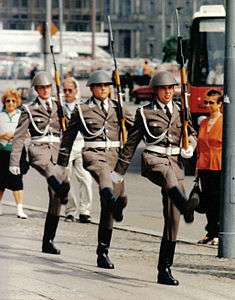
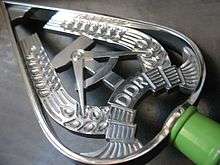
The German Democratic Republic (GDR) established the National People's Army on 1 March 1956 (six months after the formation of the West German Bundeswehr) from the Kasernierte Volkspolizei (Barracked People's Police). This formation culminated years of preparation during which former Wehrmacht officers and communist veterans of the Spanish Civil War helped organize and train paramilitary units of the People's Police. Though the NVA featured a German appearance – including uniforms and ceremonies patterned after older German military traditions – its doctrine and structure showed the strong influence of the Soviet Armed Forces.
During its first year, about 27 percent of the NVA's officer corps had formerly served in the Wehrmacht. Of the 82 highest command positions, ex-Wehrmacht officers held 61; however, very few of them had served in high ranks. The military knowledge and combat experience of these veterans were indispensable in the NVA's early years, although by the 1960s most of these World War II veterans had retired. (The West German Bundeswehr similarly relied on Wehrmacht veterans, who initially comprised the majority of its commissioned ranks.)
In its first six years the NVA operated as an all-volunteer force. (West Germany, in contrast, re-introduced universal military service in 1956.) The GDR introduced conscription in 1962. According to the Parallel History Project on Cooperative Security:
the NVA was incorporated in the Warsaw Pact and consisted of army, air force/air defense (Luftstreitkräfte/Luftverteidigung), and the People’s Navy (Volksmarine). At its peak in 1987, the three NVA services had about 156,000 men under arms altogether. Between 1956 and 1990, about 2.5 million male GDR citizens performed army duty.[2]
Like the ruling communist parties of other Soviet satellites, the East German Socialist Unity Party of Germany (SED) assured control by appointing loyal party members to top positions and by organizing intensive political education for all ranks. The proportion of SED members in the officer corps rose steadily after the early 1960s, eventually reaching almost 95 percent.
The NVA saw itself as the "instrument of power of the working class" (Machtinstrument der Arbeiterklasse).[3] According to its doctrine, the NVA protected peace and secured the achievements of socialism by maintaining a convincing deterrent to imperialist aggression. The NVA's motto, inscribed on its flag, read: "For the Protection of the Workers and Farmers' Power".
The NVA never took part in full-scale combat, although it participated in a support role in the suppression of the Prague Spring of 1968, and NVA officers often served as combat advisers in Africa.[4] Some of the first NVA advisors went to the Republic of the Congo in 1973. During the 1980s at various times the NVA had advisors in Algeria, Angola, Ethiopia, Guinea, Iraq, Libya, Mozambique, South Yemen, and Syria.[5] When the Soviet Union prepared to occupy Czechoslovakia in 1968, the GDR government committed the 7th Panzer Division and the 11th Motorised Infantry Division to support the intervention (assigned to 20th Guards Army and 1st Guards Tank Army respectively), becoming the first deployment of German troops outside Germany for the first time since the Second World War.[6] But the East German participation raised Czech ire, and the two divisions were "kept out of sight in the Bohemian forests" (Tsouras, 1994, 170) and allowed to travel only at night. In a few days they were withdrawn.
_1981%2C_MiNr_2580.jpg)
In the early 1970s the Group of Soviet Forces in Germany (GSFG) high command assigned to the NVA the wartime mission of capturing West Berlin.[7] The NVA plan for the operation, designated "Operation Centre", called for some 32,000 troops in two divisions, accompanied by the GSFG's Soviet 6th Separate Guards Motor Rifle Brigade. The plan was regularly updated until 1988, when a less ambitious plan that simply aimed at containing Berlin was substituted.
In the autumn of 1981 the NVA stood ready to intervene in Poland in support of a possible Soviet invasion, but the declaration of martial law in Poland (13 December 1981) averted the crisis.
The NVA went into a state of heightened combat readiness on several occasions, including the construction of the Berlin Wall in 1961, the Cuban Missile Crisis in 1962, the 1968 Warsaw Pact invasion of Czechoslovakia, and, for the last time, in late 1989 as protests swept through the GDR.
Ideology
The NVA operated as a professional volunteer army until 1962, when conscription was introduced. The GDR's National Defense Council controlled the armed forces, but the mobile forces came under the Warsaw Pact Unified Command. Political control of the armed forces took place through close integration with the Socialist Unity Party of Germany (SED), which vetted all the officers. Military training (provided by the school system) and the growing militarization of East German society bolstered popular support for the military establishment. From a Leninist perspective, the NVA stood as a symbol of Soviet-East German solidarity and became the model Communist institution – ideological, hierarchical, and disciplined.[8] The NVA synthesized Communist and Prussian symbolism, naming its officers' academy after Karl Marx's co-author Friedrich Engels, and its highest medal after Prussian General Gerhard von Scharnhorst.[9]
During the popular demonstrations of 1989 that led to the downfall of the GDR's Communist government, some NVA forces were placed on alert but were never deployed against protestors. At the same time, the Soviet government ordered its troops in the GDR to remain in barracks. After the forced retirement of SED and state leader Erich Honecker and other conservatives from the ruling Politburo at the height of the crisis in October 1989, the new SED leadership never considered the possibility of using armed force against the "Peaceful Revolution".[10]
Composition
The manpower of the NVA consisted of some 85,000 soldiers in 1962, climbed to 127,000 by 1967, and remained essentially steady through 1970.[11] In 1987, at the peak of its power, the NVA numbered 175,300 troops. Approximately 50% of this number were career soldiers, while the others were short-term conscripts.
According to a 1973 study, NVA leaders from the late 1950s through the 1960s came predominantly from working-class backgrounds, with few from middle-class or professional families and no representatives of the aristocracy present in the upper echelons. Excepting specialized military or political instruction, most NVA leaders reported primary school as their highest level of formal education.[12]
Post-unification
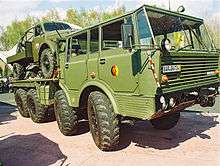
The NVA disbanded with the dissolution of the East German government in October 1990. Its facilities and equipment were handed over to the Bundeswehr. Most facilities closed, and equipment was either sold or given to other countries. Most of the NVA's 36,000 officers and NCOs were let go, including all officers above the rank of lieutenant colonel. The Bundeswehr retained only 3,200 – after a demotion of one rank. In addition, all female soldiers (at this point it was prohibited for women to become soldiers in the Bundeswehr) and all soldiers over the age of 55 were discharged.
Until 1 March 2005, Germany listed time served in the NVA as time "served in a foreign military". Service in the NVA did not count for points towards federal pensions in the unified Germany. Retired NVA soldiers and officers received only minimal pensions after unification: a thirty-year veteran would receive a pension smaller than a graduate-student stipend. After the reform of 2005, service in the NVA became known as "served outside of the Bundeswehr".
Many former NVA officers feel bitter about their treatment after unification. While receiving only minimal pensions, few have been able to find jobs except as laborers or security guards. Former NVA officers are not permitted to append their NVA rank to their name as a professional title; no such prohibition applies to rank attained in the Wehrmacht or in the Waffen-SS during the Nazi era.[13]
One of the few former NVA facilities not closed was its Storkow base near Berlin, which housed the NVA's camouflage and deception center. This became the Bundeswehr Unit for Camouflage and Deception.[14]
Former Wehrmacht soldiers in the NVA
The following list includes the NVA generals and admirals who were awarded the German Cross in the Wehrmacht during the Second World War with the date of the awards as well as the rank held at the time listed after the name.[15]
- Generalmajor Rudolf Bamler (12 March 1942 as Oberst)
- Generalmajor Bernhard Bechler (28 January 1943 as Major)
- Generalmajor Dr. rer. pol. Otto Korfes (11 January 1942 as Oberst)
- Generalmajor Arno von Lenski (21 January 1943 as Generalmajor)
- Generalleutnant Vincenz Müller (26 January 1942 as Oberst i.G.)
- Generalmajor Hans Wulz (25 January 1943 as Generalmajor)
The following list includes the NVA generals and admirals who were awarded the Knight's Cross of the Iron Cross in the Wehrmacht during the Second World War with the date of the awards as well as the rank held at the time listed after the name.[16]
- Generalmajor Wilhelm Adam (17 December 1942 as Oberst)
- Generalmajor Dr. rer. pol. Otto Korfes (22 January 1943 as Generalmajor)
- Generalleutnant Vincenz Müller (7 April 1944 as Generalleutnant)
Utilization of former NVA materiel after 1990
.svg.png)
The NVA was, in relation to its equipment and training, one of the strongest armies in the Warsaw Pact. It was equipped with a large number of modern weapons systems, most of Soviet origin, from which a small portion were given back to the Soviet Union in 1990.
The remaining equipment and materiel was very substantial. Large quantities of replacement parts, medical supplies, atomic, biological and chemical warfare equipment, training devices and simulators, etc. had to be disposed of.
One of the first measures taken after reunification was a survey and securing of weapons and devices by former members of the NVA. The federally operated Materiel Depot Service Gesellschaft (MDSG) was charged with taking custody of and warehousing this equipment. The MDSG employed 1,820 people who were primarily taken from the Bundeswehr. The MDSG was privatised in 1994. Unless the defense material was given free of charge to beneficiaries in the new federal states or other departments, to museums, or to friendly nations in the context of aid supplies in third world nations, it was destroyed.
Left behind were:
- 767 aircraft (helicopters, fixed wing aircraft), 24 of which were MiG-29s
- 208 ships
- 2,761 tanks
- 133,900 wheeled vehicles
- 2,199 artillery pieces
- 1,376,650 firearms
- 303,690 tons of ammunition
- 14,335 tons of fuel and cleaning materials
Recruitment and conscientious objection
Before the construction of the Berlin Wall in 1961, military service in the GDR was voluntary, though the Free German Youth and public schools mounted intensive recruitment drives and service in the NVA was often a prerequisite for career advancement. Compulsory service had been introduced earlier in West Germany (1956) – one year after the Federal Armed Forces were established – but the GDR held back from this step until 1962. The situation changed when the border was sealed in August 1961, and five months later the government announced a mandatory service term of 18 months for men.
There was, at first, no alternative service for conscientious objectors. This changed in 1964 when, under pressure from the national Protestant church, the GDR's National Defense Council authorized the formation of Baueinheiten (construction units) for men of draft age who "refuse military service with weapons on the grounds of religious viewpoints or for similar reasons".
The construction soldiers wore uniforms and lived in barracks under military discipline, but were not required to bear arms and received no combat training. In theory, they were to be used only for civilian construction projects. The GDR therefore became the only Warsaw Pact country to provide a non-combat alternative for conscientious objectors. However, fearing that other soldiers would be contaminated by pacifist ideas, the government took care to segregate the construction units from regular conscripts. Moreover, conscripts who chose the alternative service option often faced discrimination later in life, including denial of opportunities for higher education.
Organization
The NVA had four main branches:[17]
- The Landstreitkräfte (Ground Forces) with an active strength of 108,000 in the following divisions:
- 1. Motorisierte-Schützen-Division (Potsdam-Eiche)
- 4. Motorisierte-Schützen-Division (Erfurt)
- 7. Panzerdivision (Dresden)
- 8. Motorisierte-Schützen-Division (Schwerin)
- 9. Panzerdivision (Eggesin)
- 11. Motorisierte-Schützen-Division (Halle)
- The Volksmarine (People's Navy) with a strength of 18,300.
- The Luftstreitkräfte/Luftverteidigung (Air Forces/Air Defence) with a strength of 58,000.
In wartime, mobilization of the NVA's reserves would have nearly doubled its strength. GDR authorities also had at their disposal the internal security troops of the Ministry of the Interior (the Kasernierte Volkspolizei or garrisoned People's Police) and the Ministry for State Security (the Felix Dzerzhinsky Guards Regiment) along with the 210,000 strong party auxiliary "Combat Groups of the Working Class" (Kampfgruppen der Arbeiterklasse), who were available in times of war.
The highest level of leadership for the NVA was the Ministry for National Defense (Ministerium für Nationale Verteidigung) headquartered in Strausberg near East Berlin. NVA administration was divided into the following commands:
- the Kommando Landstreitkräfte (KdoLaSK) based in Geltow near Potsdam.
- the Kommando Luftstreitkräfte und Luftverteidigungskräfte (KdoLSK/LV) based in Strausberg.
- the Kommando Volksmarine (KdoVM) based in Rostock.
- the Kommando der Grenztruppen (KdoGT) based in Pätz near Berlin.
Appearance
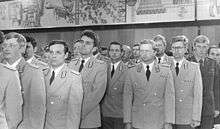
Uniforms
The first military units of the Central Training Administration (Hauptverwaltung Ausbildung – HVA) were dressed in police blue. With the restructuring of the Barracked Police (CIP) in 1952, khaki uniforms similar in shape and color to those of the Soviet Army were introduced. The desire for a separate "German" and "socialist" military tradition, and the consequent founding of the NVA in 1956, introduced new uniforms which strongly resembled those of the Wehrmacht. They were of a similar cut and made of a brownish-gray, called stone gray, cloth. The dark high-necked collar were later removed, except on the coats from 1974–79.
Even the NVA's peculiar "gumdrop" army helmet, in spite of its easily noticeable resemblance to well-known Soviet designs, was actually based on a prototype "B / II" helmet that was initially developed for the Wehrmacht by Prof. Dr.-Ing. Fry and his collaborator Dr. Hansel from the Institute for Defense Technical Materials Science in Berlin. The helmet had seen trials since 1943, but was not adopted during World War II.[18]
With the exceptions of the People's Navy, whose dark-blue uniforms were consistent with the styles of most navies around the world, and the Combat Groups of the Working Class (Kampfgruppen der Arbeiterklasse), who wore their own olive-green fatigue uniforms, all NVA armed services, the Felix Dzerzhinsky Guards Regiment, the Border Troops of the German Democratic Republic, and the Barracked People's Police (Kasernierte Volkspolizei) wore the same basic uniform. Several later modifications were introduced, but the style and cut remain fundamentally the same. There were a variety of uniforms worn according to the setting (work or social) and season (summer or winter). Most uniforms (service, semi-dress, and parade) were stone gray, a brownish-gray color that was conspicuously different from the gray-green of the People's Police. Officers' uniforms differed from those of enlisted personnel by better quality and texture cloth. The field and service uniforms were normal attire for most day-to-day functions.
Uniform categories
Basic categories of uniforms were worn:
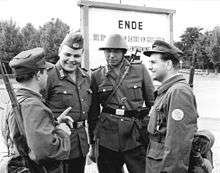
_1981%2C_MiNr_2581.jpg)
.jpg)
- Parade uniform (Paradeuniform) – The parade uniform for officers was the semi-dress/walking-out tunic with all authorized orders, awards and decorations attached, breeches and riding boots, steel helmet, white shirt, dark-gray necktie, and a ceremonial dagger worn on the left side and fastened to a silver-gray parade belt. Officers in guards of honor carried sabers. In winter, a greatcoat, scarf, and gloves were worn.
- Service uniform (Dienstuniform) – The summer service uniform for officers was a bloused jacket, called a Hemdbluse, worn without a shirt, trousers, and a visored service cap. The winter service uniform featured a tunic with four large buttoned-down patch pockets, a black waist belt, the service cap, breeches, shirt, tie, and pants belt; high boots were reserved for officers and NCOs. A long, heavy, belted greatcoat was also part of the winter uniform.
- Semi-dress/walking-out uniform (Ausgangsuniform) – With a few details, the semi-dress uniform was the same for all ranks and was worn for walking-out purposes (i.e. off-duty and off-post). It consisted of a single-breasted tunic without belt, a silver-gray shirt with dark-gray tie, the service cap, long trousers, and black low-quarter shoes. Officers also wore the tunic with a white shirt. During periods of warm weather, there was the option of omitting the tunic, and furthermore omitting the tie. A double-breasted jacket was optional for officers and warrant officers.
- Field service uniform (Felddienstuniform) – The summer field uniform for both officers and enlisted consisted of a jacket and trousers in Strichtarn, a dark-brown (later a forest green) raindrop camouflage pattern on a stone-gray background; a field cap, service cap, or steel helmet; high black boots; and a gray webbing belt with y-strap suspenders. In winter, a quilted stone gray padded suit without a camouflage pattern was worn over the service uniform. Later winter uniforms were also of the same camouflage pattern as the summer variant. The winter uniform also included a fur pile cap or a steel helmet, boots, knitted gray gloves, belt, and suspenders.
- Work uniform (Arbeitsuniform) – Seasonal considerations and weather governed the kind of work uniforms worn. Generally, reconditioned articles of service uniforms (field, semi-dress, and padded winter uniforms) were dyed black and issued for all types of fatigue and maintenance details. Coveralls are also used by the lower ranks, especially armor and air force personnel. Officers in technical branches supervising fatigue details wore a laboratory-style smock.
- Other uniforms – High-ranking officers occasionally wore white uniforms (or white jackets), and staff officers were issued distinctive staff service uniforms. Women wore uniforms consisting of jackets, skirts or slacks, blouses, caps, boots or pumps, and other appropriate items according to season and occasion. Personnel such as paratroopers, motorcyclists, and tank troops wore additional items with their uniforms identifying them as such.
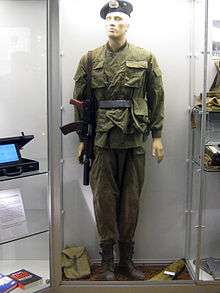
Waffenfarben
NVA uniforms initially wore the Waffenfarben as worn by the Wehrmacht, but later reverted to white except for generals who wore red.
The uniform of the Border Troops was distinguished from that of the NVA ground force and Air Force/Air Defense Force by a green armband with large silver letters identifying the wearer's affiliation.
Felix Dzerzhinsky Guards Regiment uniforms were nearly identical to those of the (NVA) and were distinguished primarily by the dark red MfS service color of its insignia and by an honorary cuff-band on the left sleeve bearing the regiment's name. Other Stasi officers wore a similar uniform, but without the cuff-band.
Rank insignia
East German armed forces personnel display rank insignia on shoulder boards or shoulder loops on service, semi-dress, and parade uniforms, and subdued sleeve insignia midway between the shoulder and elbow on the left sleeve of the field uniform, coveralls, or other special uniforms. General officer rank is denoted by five-pointed silver stars mounted on a gold and silver braided shoulder cord set on a bright red base. All other officers and NCOs wear a four-pointed star. Like many of the other Warsaw Pact countries, NVA rank insignia followed the Soviet pattern in the arrangement of stars.
The Volksmarine followed similar shoulder insignia for the naval officers (who also used sleeve insignia) and enlisted ratings except that these were blue and white or yellow (in the case of naval ratings).
Awards and decorations
The GDR had some seventy decorations for persons or groups it wished to recognize, and it bestowed them liberally. Some, such as battle decorations, were specifically set aside for armed forces personnel, many awarded to soldiers and civilians alike, and others, although ordinarily civilian awards, can on occasion be earned by those on military duty. The latter group included decorations for achievement in the arts, literature, production, and work methods. They were awarded to service personnel or specific units that participated in civil production projects or assisted during harvesting.
The Order of Karl Marx, Patriotic Order of Merit, Star of People's Friendship, Banner of Labor, Order of Scharnhorst, and the National Prize were among the more important awards. Some, including the Order of Merit and the Star of People's Friendship, were awarded in three classes. A few were accompanied by substantial monetary premiums. The NVA did not permit military personnel to wear Wehrmacht awards and decorations.
Periodicals
The two main periodicals of the NVA were the weekly newspaper Volksarmee and the monthly soldier's magazine Armeerundschau.
Relics
The former Nazi holiday complex at Prora, on the island of Rügen, contains a number of museum displays. One of these is devoted to the NVA, which had used part of the complex as a barracks. Many German military museums host former NVA equipment like tanks and aircraft.
See also
References
- 1 2 3 Trainor, Bernard E.; Times, Special to the New York (8 November 1988). "East German Military: Warsaw Pact's Finest" – via NYTimes.com.
- ↑ Parallel History Project on Cooperative Security, "The GDR in the Warsaw Pact" (28 October 2016)
- ↑
Sabrow, Martin; von Scheven, Werner (2007). Thoß, Bruno, ed. Die Geschichte der NVA aus der Sicht des Zeitzeugen und des Historikers [The history of the NVA from the viewpoint of contemporaries and of the historian]. Potsdamer Schriften zur Militärgeschichte (in German). 3. Deutschland Militärgeschichtliches Forschungsamt. BoD – Books on Demand. p. 21. ISBN 9783980888240. Retrieved 2016-06-01.
Ihrem Selbstverständnis nach war die NVA das Machtinstrument der Arbeiterklasse ...
- ↑ Tsouras, 1994, 250.
- ↑ IISS Military Balance 1981-89, via Tsouras, 1994, 250.
- ↑ Tsouras, "Changing Orders", Facts on File, 1994, 170.
- ↑ David Stone, Fighting for the Fatherland: The Story of the German Soldier from 1648 to the Present Day, Conway, London, 2006, p.385-6, ISBN 1-84486-036-1, drawing upon Colonel AD Meek, "Operation Centre", British Army Review, No. 107, 1994
- ↑ Emily O. Goldman and Leslie C. Eliason, The diffusion of military technology and ideas (2003) p 132
- ↑ Alan L. Nothnagle, Building the East German myth (1999) p 176
- ↑ Dale Roy Herspring, Requiem for an army: the Demise of the East German Military (1998)
- ↑ Hancock, M. Donald. The Bundeswehr and the National People's Army: A Comparative Study of German Civil-Military Polity. University of Denver, 1973. p 25.
- ↑ Hancock, M. Donald. The Bundeswehr and the National People's Army: A Comparative Study of German Civil-Military Polity. University of Denver, 1973. p 12-13
- ↑ Bickford, Andrew (2009). "Soldiers, Citizens, and the State: East German Army Officers in Post-Unification Germany". Comparative Studies in Society and History. 51 (2): 260–287. doi:10.1017/S0010417509000127.
- ↑ " East German army unit finds skills still in demand after reunification". DW (Deutsche Welle) website, 16 August 2010
- ↑ Generals & Admirals who were awarded the Knight's Cross in the Axis History Factbook
- ↑ Generals & Admirals who were awarded the German Cross in the Axis History Factbook
- ↑ Forester, Thomas M., The East German Army; Second in the Warsaw Pact, George Allen & Unwin Ltd, London, 1980
- ↑ Baer, Ludwig: Die Geschichte des Deutschen Stahlhelmes: von 1915 bis 1945; seine Geschichte in Wort u. Bild . L. Baer (Selbstverlag), Eschborn, 1977.
- Hancock, M. Donald. The Bundeswehr and the National People's Army: A Comparative Study of German Civil-Military Polity. University of Denver, 1973.
- Tsouras, P.G. Changing Orders: The Evolution of the World's Armies, 1945 to the Present Facts On File, Inc, 1994. ISBN 0-8160-3122-3
- David Stone, 'Fighting for the Fatherland: The Story of the German Soldier from 1648 to the Present Day,' Conway, London, 2006
![]()
Further reading
- Bickford Andrew. Fallen Elites: The Military Other in Post-Unification Germany (Stanford University Press; 2011); 288 pages; An ethnographic study of former East German officers.
- Dale Roy Herspring, Requiem for an army: the demise of the East German military, Rowman & Littlefield Publishers, 1998, ISBN 0-8476-8718-X, 9780847687183, 249 pages
- Jörg Schönbohm, Two armies and one fatherland: the end of the Nationale Volksarmee, Berghahn Books, 1996, ISBN 1-57181-069-2, ISBN 978-1-57181-069-4
- Zilian, Jr., Frederick. 'From Confrontation to Cooperation: The Takeover of the National People's (East German) Army by the Bundeswehr,' Praeger, Westport, Conn., 1999, ISBN 0-275-96546-5. Reviewed by Dale R. Herspring in The Journal of Military History, July 2000, p. 912-914
External links
- PHP Editors. "The GDR in the Warsaw Pact". www.php.isn.ethz.ch. Retrieved 2017-06-30.
- NVA Forum (in German)
- Nationale Volksarmee & the GDR Forum
- AHF - Nationale Volksarmee (NVA)
- kamouflage.net > Europe > Germany, Democratic Republic of
- RFE/RL East German Subject Files: Armed Forces Open Society Archives, Budapest